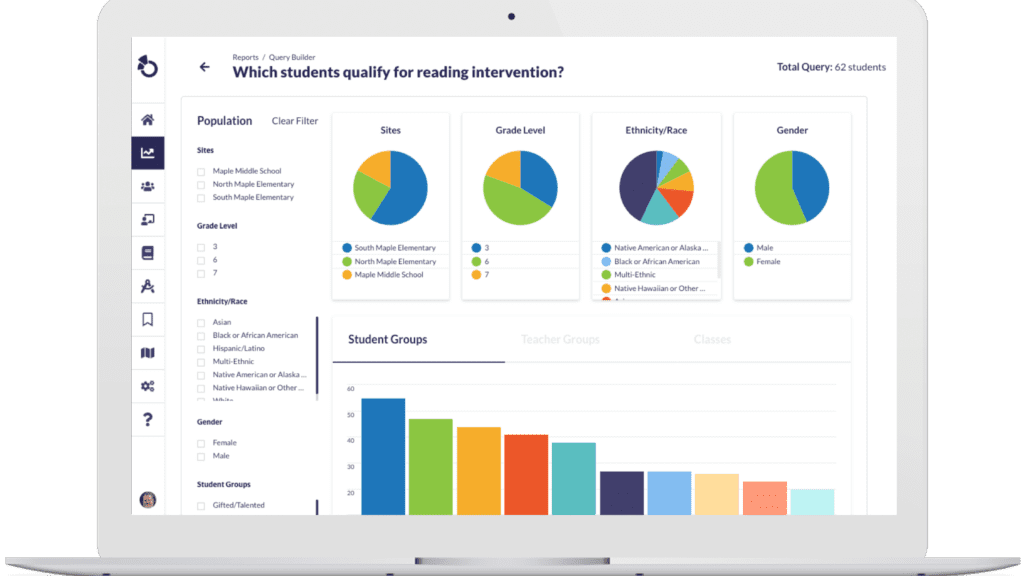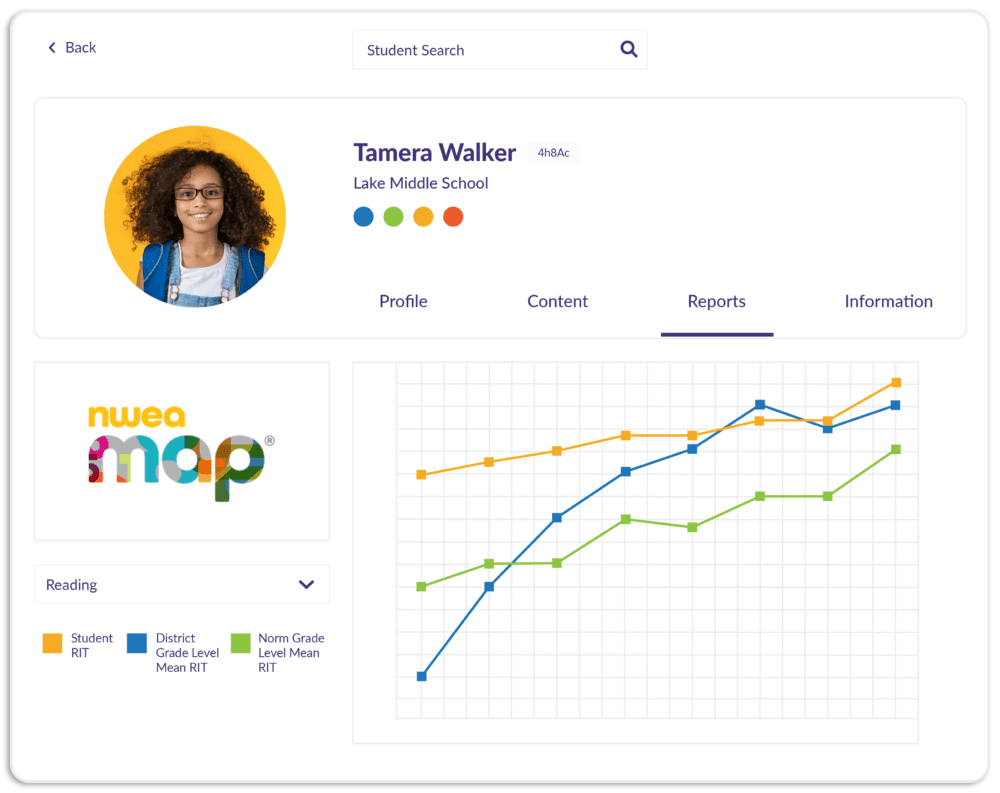9 Non-Negotiables When Choosing a K-12 Data and Assessment System
By: David Specht
K-12 educators are constantly seeking tools that not only simplify their workload but also enhance the learning experience for their students. This is where the need for an intuitive, flexible, and K-12-focused data, assessment, and grading platform comes into play. Having the right tool is crucial – it can mean the difference between a streamlined educational process and a complicated one. Let's dive into the nine non-negotiables to consider when selecting a system for your school!
1. Assessment Options
Variety is the spice of life, and this holds true for educational assessments too. A versatile system should offer a range of assessment options, from multiple-choice to short answers, to cater to different learning and teaching styles. This variety not only keeps students engaged but also allows educators to assess learning in multiple ways.
Otus takes the challenge of assessing student learning and turns it into a streamlined, intuitive process. With tools to create custom assessments for every grade level and subject area, educators have access to a vast library of item banks and questions. The process of building assessments is simple and quick, offering common question types like multiple choice, short answer, and true or false. Additionally, questions can be aligned with CCSS, NGSS, and other standards. For more advanced needs, Otus integrates with numerous item banks for tech-enhanced question types and allows educators to create custom rubrics. These rubrics are not only easy to build and reusable but also align with various educational standards, making them perfect for project-based learning and integration with tools like Google Docs.
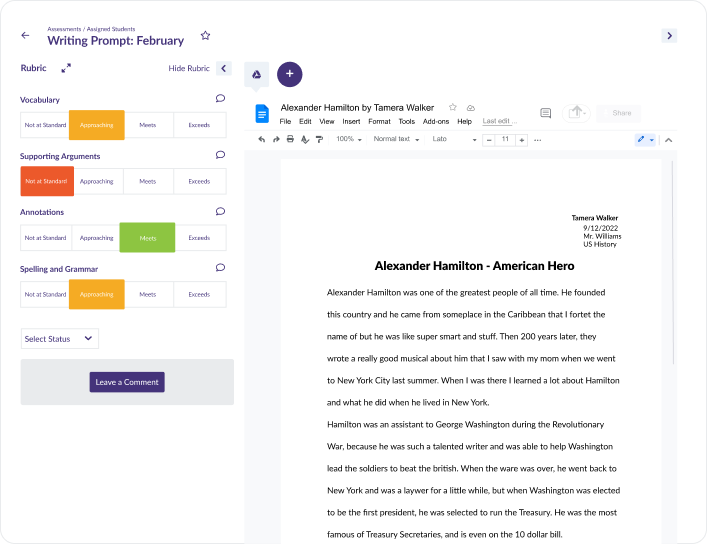
Rubrics in Otus can be used to clearly outline expectations for both academic and non-academic skills so students can clearly see where they fall in relation to the defined criteria and descriptors.
2. Common Assessments Simplified
Collaboration is key in education. A system that allows teachers to create, share, and modify common assessments can foster a collaborative environment. This not only saves time but also ensures consistency in evaluating student performance across different classes and grades.
Otus simplifies the collaboration process among educators. It offers an easy way for teachers to work together and ensure that every student takes the same assessment, thus maintaining uniformity in evaluation. Educators can reuse and share content, including assessments, with their colleagues, whether they're in a neighboring classroom or a school across town. This sharing can be done with teams of teachers or on an individual basis, allowing for flexibility in how assessments are distributed and assigned.
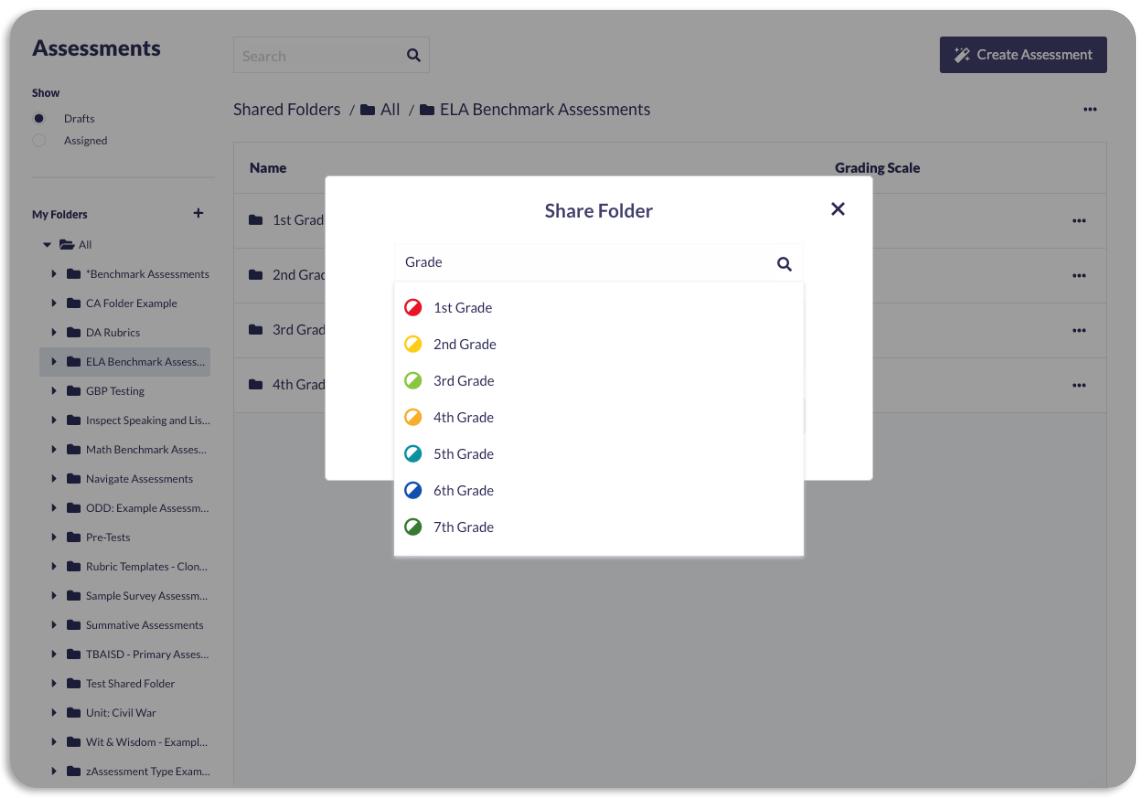
Administrators can easily share a folder of assessments with teachers in Otus.
Furthermore, Otus provides control over which assessments can be copied and edited. This feature is critical in maintaining the integrity of common assessments and ensuring that all students are evaluated on a consistent basis. With Otus, common assessments are not only possible but are also streamlined and efficient, enabling educators to focus more on teaching and less on the logistics of assessment distribution.
3. Efficiency is Key: Streamlining Assessment Creation
Why start from scratch when you don’t have to? An ideal platform allows educators to tap into pre-existing assessments or modify them to suit their needs, year after year, and across classrooms. This feature saves precious time and energy, allowing teachers to focus more on teaching and less on administrative tasks.
Otus takes streamlining assessment creation to a new level. Imagine having a plethora of ready-to-use assessments from top K-12 education companies at your fingertips, directly integrated into Otus. These prebuilt assessments come with benefits like auto-scoring, standards alignment, and automatic transfer to your gradebook. Moreover, Otus offers a wealth of over 1,200 proficiency assessments in reading, language usage, and math. These are not just any assessments; they are aligned with Common Core and state standards, vetted by content experts, and mirror the style of high-stakes digital assessments. This feature is perfect for both formative and summative assessments.
Additionally, Otus includes an AI Question Generator, an innovative tool that automatically generates multiple-choice, true/false, and short answer questions. These questions can be linked to learning standards, ensuring that the content is tailored and relevant. The best part? It's fully integrated into Otus, requiring no additional add-ons, thus significantly reducing the workload for educators and allowing them to devote more time to what matters most – their students.
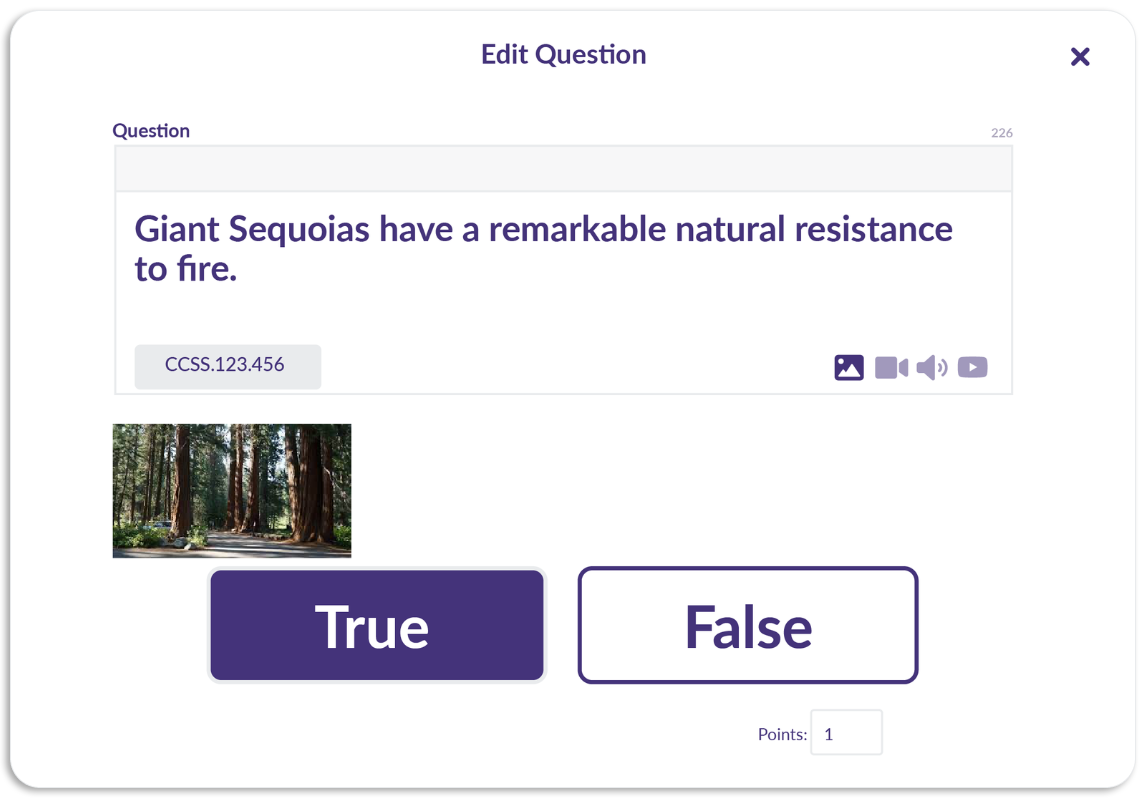
Use Otus’ embedded AI tool to automatically generate multiple choice, true/false, and short answer questions.
4. Mistakes Happen: Easy Editing of Assessments
Flexibility in editing assessments is crucial. Whether it's adding a question or correcting an answer, the ability to make changes (especially after students have begun testing) is invaluable. This feature prevents the headache of manual grading and ensures accuracy in assessments.
Otus makes it easy for educators to keep their assessments accurate and current. If a mistake is spotted after students have started testing, teachers can quickly correct it, like changing a wrong answer. This is a big deal as many other programs don't allow such edits, leading to the hassle of manual grading. With Otus, teachers can adapt on the fly, ensuring that grading stays smooth and the results remain reliable. This flexibility is key in today’s dynamic world of education.
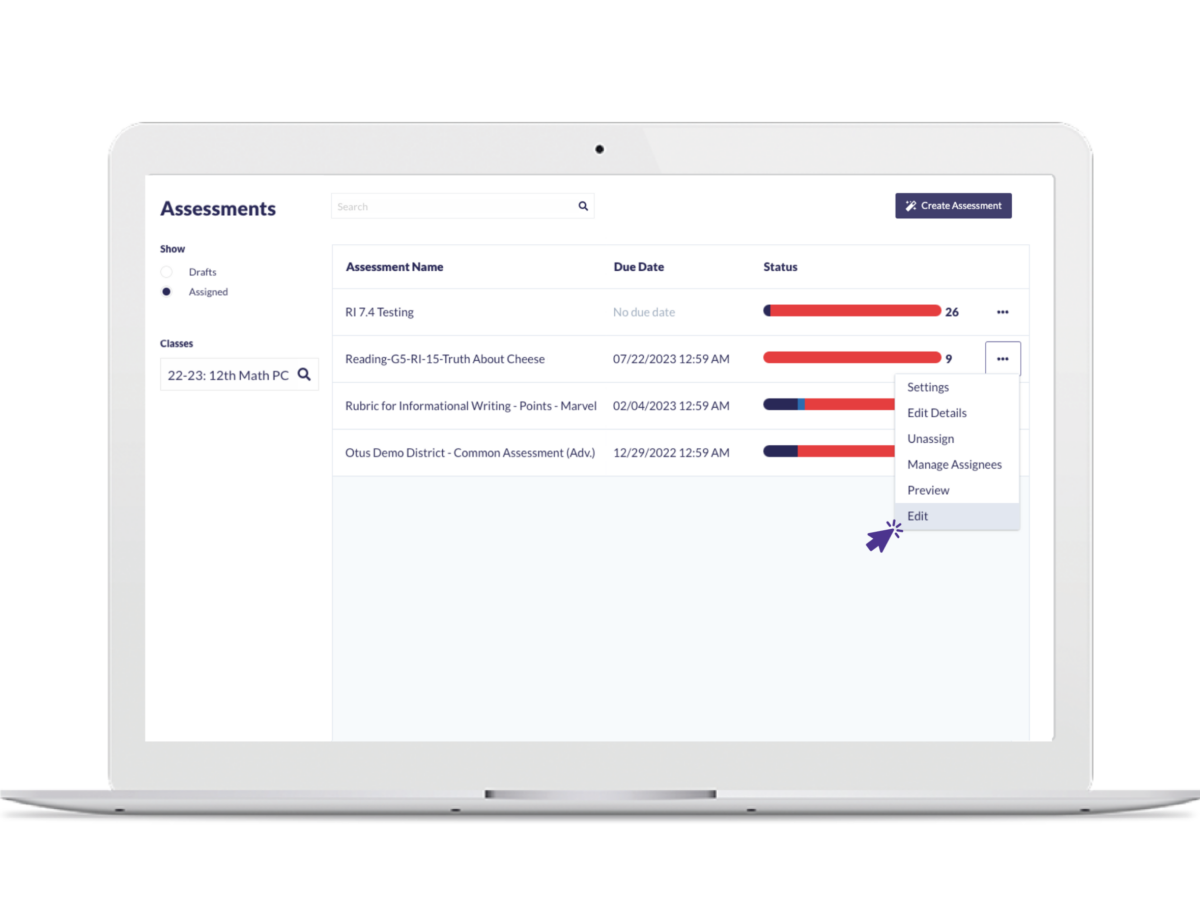
Educators can easily adjust an assessment after it has been assigned to students.
5. Adaptable Gradebook
A flexible gradebook that can adapt to various grading systems is essential. This flexibility helps in creating a seamless workflow, ensuring that all student data is synchronized and easily accessible.
Otus offers a versatile gradebook that can easily support traditional and standards-based. This adaptability is perfect for educators' diverse needs. Real-time data from assessments and standards are readily available for both students and families, improving transparency and understanding.

Otus’ standards-based gradebook streamlines the assessment, tracking, and reporting of student progress toward standards.
For families, the Otus Family Gradebook simplifies tracking student progress, offering a clear snapshot of both academic and non-academic performance. It aligns with educational best practices, making it easier for families to understand and engage with their child's learning journey. Additionally, Otus enhances the understanding of student growth by identifying specific strengths, weaknesses, and opportunities for tailored learning strategies.
6. Robust Integrations
Integrating with other educational tools and platforms can significantly enhance functionality. A system that can seamlessly blend with other tools can create a more comprehensive and efficient educational ecosystem.
Otus is great at integrating with popular educational tools like Google, Respondus, Desmos, Turnitin, Texthelp and more. This smooth integration means teachers can keep using their favorite tools without any hassle, all while taking advantage of Otus' features.
These integrations make tasks like creating assessments and managing data easier, letting teachers focus more on teaching. It's not just about making things simpler for teachers, though; this seamless connection also means a better, more connected learning experience for students.
7. Comprehensive Analytics: All Your Data in One Place
A platform that offers robust analytics beyond just assessment scores can be a game-changer. Having access to a holistic view of student performance, including various data points, helps in making informed decisions and tailored instructional strategies.
Otus is a one-stop shop for all student data, combining results from classroom assessments and external tests for a full performance picture. The platform is easy to use and quickly provides key insights – not just heaps of data.
The student profile feature in Otus is a standout, collecting every piece of data about a student in one spot. This makes it simple for teachers to use all sorts of assessment data for informed decisions. Otus' analytics tools let teachers dive deep into how students perform on assessments, understanding where they excel and where they need more help.
For school leaders, Otus offers a dashboard that shows how the entire school or district is using Otus, from assessment trends to login patterns. This big-picture view helps in making decisions that support teachers and students better.
In short, Otus makes it easier for educators to use data effectively, helping them focus on what they need to improve teaching and learning.
8. Personalized Onboarding and Ongoing Support
Transitioning to a new system can be challenging. Personalized onboarding and continuous support are crucial in ensuring a smooth transition and ongoing usage. This support can make a significant difference in how effectively the platform is utilized.
Otus takes client support seriously, providing each school with a dedicated Client Experience Partner (CXP) from the get-go. This personalized approach helps schools set up the Otus system in a way that fits their unique needs. The CXP not only assists with the initial implementation but also offers ongoing training, both online and in person.
Support at Otus extends way beyond setup. The Otus team, filled with former educators, offers quick, real-time help through a chat function, ensuring any issues are addressed swiftly (with an average response time of under three minutes and a user rating of 98.7%). Otus also continues to support educators with regular, focused training sessions, both live and on-demand, fostering a culture of continuous learning.
Otus' approach to support is comprehensive and empathetic, focusing on building a partnership with educators and evolving based on their feedback and needs. This ensures that users of Otus feel supported and valued throughout their experience with the platform.

9. Ensuring Student Security
Last but certainly not least, the security of student data is crucial. A trustworthy platform must have robust security measures in place to protect sensitive information, ensuring peace of mind for both educators and parents.
Otus takes the security of student data very seriously. The platform uses strong security features, including special access codes for families and the ability to set different permission levels at the school. This way, Otus makes sure that student information is both accessible and well-protected.
Otus is committed to keeping student data safe, following rules set by the Student Privacy Pledge and the TrustEd Apps Pledge. Otus also carefully checks its app for security. This includes tests done by their own team and by outside experts who specialize in finding security weaknesses. This thorough approach to security means that both teachers and parents can trust Otus to keep student information safe.
Request a demo!
See exactly how Otus can help your school accelerate student growth and improve student outcomes – all while saving educators time.
